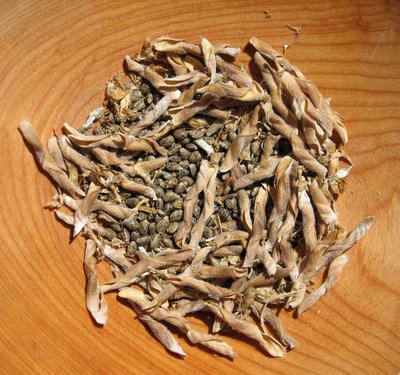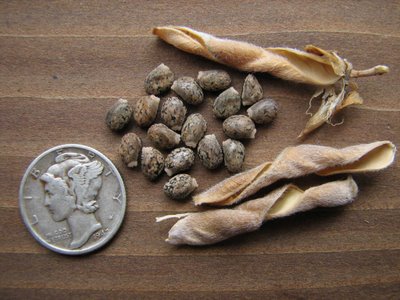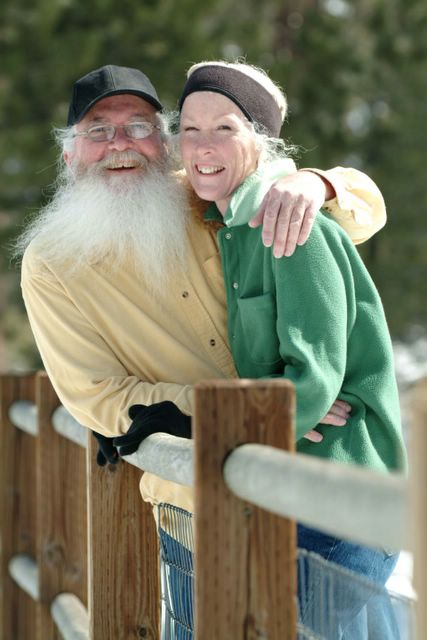Saving The Seed Of Giant Lupine
These are seed-saving days around here and I’ve just finished collecting and cleaning the seeds of our Giant Lupine (Lupinus polyphyllus), a nitrogen fixing legume in the pea family with a very neat seed dispersal method.
When the seeds are mature, and the casings have completely dried out, they snap open with a forceful spiral twist which sends the seeds flying some distance from the parent plant so they might find their own place in the sun.
The first time I collected seed from Grape Soda Lupine (Lupinus excubitus), another native lupine with the same dispersal scheme, I put the seed in a bowl on top of our refrigerator. That night when Peggy and I sat down to dinner we heard these popping sounds and noticed lupine seeds were flying all over the kitchen, so after that we covered our bowls of lupine seed with a screen like you put over the frying pan to stop grease splatter.
From the time these lupine pods begin drying you only have a few days to collect the seed before they've all dispersed.
The Lupine pictured here was started in the spring of 2004 when I planted 6 seeds that I collected in the wild. These seeds have a very hard shell, so, as an experiment, I nicked the shell of 3 seeds with a small file and planted the other 3 as is, all spaced about 6 inches apart and their places marked so I'd know which ones germinated.
Two of the nicked seeds sprouted and none of the others, but one of the sprouted plants didn't come back the second year. As you can see the other is thriving and was over four feet tall this year.
The pictures below show, from top to bottom:
1. The plant just beginning to bloom.
2. A close-up of the flowers.
3. The still green pea-like seed pods.
4. Harvested seed in a bowl before separation from the chaff.
5. Seeds, and their dry twisted pods after separating, with an old dime to give an idea of the size.
6. One of the packets of seed that are now available for locals who wish to grow Big Bear native plants.
Our one mature Giant Lupine produced over 500 seeds this season and we have two younger plants coming up now as well.
Click on individual photos to enlarge






Labels: conservation, flowers, native plant garden, rewarding work, seed-saving, sustainable living


23 Comments:
We get bluebonnets here. . . I don't know if the lupine are the exact same as yours. . . but I have never been able to get a seed to grow. . .I have nicked. . . soaked. . . prayed. . . and still end up having to buy plants that are already growing. . . I have been told by locals. . . they rotate in nature growing every 2 years. That keeps a constant supply.
They are my favorite flower in Texas.
Yours are beautiful too.
Ciao
The lupine's are beautiful. I think it's such a great thing that you are collecting and distributing the seeds to re-populate Big Bear.
I don't usually comment but I always pop by, anxious for to read the newest post. It is truly my pleasure to introduce your blog to my other blogging friends.
You have been such an inspiration for me in the way you two love each other, mother earth, and life itself. I hope that I'll eventually be able to get rid of my lawn and turn it into a wildflower paradise, like yours. I've recently found a local native flower expert in my town and as soon as he has some free time I hope to be able to work with him to obtain some seed, ideas, and information.
My husband is so enamored with the idea of a wildflower garden that he wanted me to ask you how you thought we could best go about making the transformation. He wanted to kill and remove the grass, till the soil, throw down some seed, and pray for rain. I'm thinking it's a more gradual process whereby you slowly transform sections at a time.
Also, he thinks it's going to be easy and low maintenance while I think it's going to take dedication and lots of time.
Can you solve our debate and help us down the right path?
I'm going to send a link to your post over to my mother. She's been wondering how to collect the lupine seeds in her yard ever since we moved to Vermont. Thanks. :)
the lupine is really nice and the seeds look huge. nice photographs.
I had some fun cutting out and making up seed packets with these templates http://theseedsite.co.uk/envelope.html
http://theseedsite.co.uk/ is a good site with lots of inforamtion about seed collecting.
sicilian-
Texas Bluebonnet (Lupinus texensis) is a different species from the several lupines we have in Big Bear but the propogation methods are similar.
Because of their very hard shells it is recommended that Texas Bluebonnet seed be scarified (nicked, scratched, or roughed up) before planting, otherwise Lupinus texensis may take 2 or 3 years to germinate.
If you are going to nick the seeds you will need to do that in the spring and plant immediately. Water the seed regularly until they have germinated, but don't overwater because Bluebonnet doesn't like saturated soil. Don't give them fertilizer either because they are adapted to poor alkaline soils.
Texas Bluebonnet does require the presence of the bacterium Rhizobium in the soil but if Bluebonnet grows in the wild near you then Rhizobium is surely present and your soil is likely to be quite suitable.
Patience is the key with Bluebonnet, they make take a few years to become fully established on your property but once they are, if they aren't overwatered, they should naturalize, returning year after year as they do in the wild.
I have sent you an e-mail with a propagation sheet attached. I hope that will be helpful to you.
fascinating. You've inspired me to try to collect seeds of some of my own native plants right now. Wish me luck.
When I lived at a different place, there was a patch of our native lupine (Lupinus perennis) a few miles away where I would collect seeds. I was fairly successful in getting them to sprout. I'd like to get a patch started here but I don't know of a local seed source; I'll probably have to buy some. They are beautiful, and very low maintenance!
V.V.
In efforts to garden with native plants, thus preserving local habitats and ecosystems, we all inspire each other. Knowing a young couple with your naturalist ambitions encourages us too in wanting to share and communicate our love of bringing the nature of ones place home to the garden.
As far as your debate goes, in a sense, you are both correct.
For us, killing the grass was easy once I came up with method where I didn't need poisons or herbicides. I simply bought large plastic tarps from the hardware store and laid them over the grass during the hot summer months, one or two sections at a time, and burned it to death, which also killed most of the weed seeds that would've come up among the native plants.
When I was sure the grass was completely dead, with no runners or roots to resprout after the first sprinkle, I lightly tilled the soil with a hand tiller and then cast my seed on the surface and again, very lightly, raked it in.
We did the yard in sections over several years, always casting the seed in fall just before the first snow so as little seed as possible would be lost to birds, rodents, or insects. In your area you might just cast the seed at the approximate time of year that the plants would be dispersing seed.
Wildflower gardens are more work than lawns at certain times of the year because of trimming and weeding requirements, but once established, weeding becomes much less of a problem.
And as far as cost goes, native gardening is almost expense free if you do the work yourselves.
Native plants require very little water and you don't have to run to the nursery every spring to buy new beds of 'annual color'.
To have a beautiful manageable native garden you should do some research on suitable plants for your area.
Here are three books I like (all available through Amazon);
1. California Native Plants for the Garden.
2. Growing California Native Plants.
3. Gardening With A Wild Heart: Restoring California's Native Landscapes At Home.
Other Resources;
Theodore Payne Foundation For Wildflowers And Native Plants (shameless plug-they sell my native plant notecards there).
www.theodorepayne.org
Las Pilitas Native Plant Nursery in Escondido.
www.laspilitas.com
I hope this will be of some help to you.
The introduced caraganas that border nearly every yard around here have a similar spiral-splitting pod. I was planning to try to catch some seeds on a sheet this year, to experiment with cooking them, but I was away for a few days. When I came home the sidewalks were crunchy with scattered seeds.
hi lene-
cool, I hope that info is helpful to your mom with her lupine...;~)
clairesgarden-
thanks for the links to seedsite and I do sometimes print up colorful photo labels for the seed packets, especially if they're going to be gifts.
kati-
I'm glad you found the post interesting and GOOD LUCK with your seed collecting!
deb-
yeah, we have four species of native lupine in the garden, each one interestingly different and low maintenance.
laura-
I'd never heard of those caraganas, they sound pretty interesting, and I'll be checking in to see what conclusion you come to on whether they are toxic or not.
What a beautiful flower. And thanks for showing the seed process. I`d like to try planted a few seeds from some of my plants.
tea
xo
I love lupines!
They grow all over by the roadside where I live and I have some of my own in my garden, although not the large variety you have there.
Today I was collecting seed too..mostly hollyhocks.
You make it difficult not to litter comments here and there and over there when visiting. You have so many excellent postings.
I've included you in the current installment of A Hitchhiker's Guide To The Blogosphere at Fear And Loathing - The Gonzo Papers
Hoping you'll have an opportunity to come by for a visit. Look forward to any comments you might have. Should you choose to write, I will do the same. As I said, concerned about writing comments.
By the way, LOVE the Neil Young album cover.
very cool Jim!
Thanks a lot for showing the seed process as you konw I will need that next year.
Meanwhile, I've seen somewhere on my blog that you asked how to put videos on your blog; you have to go to YouTube and register. You'll see there how to do it, pls choose "videos" after having registered. For instance, my last post is Bob Dylan's "Master of War".
I don't see lots of lupines here, and so, enjoyed your description of how the seeds survive.
please drop by my blog as I pay tribute to the 2996 casualties of the WTC 9-11 attack
Wow. No wonder my lupins are popping up all over my garden!
I just wish I had a cure for the little green wedge shaped hoppers that kill all my mature plants every year. Raid gets them, but I hate spraying poison all over the ground.
Cool directions! Thanks for sharing. It is a nice plant. I have a lupine in my yard, but I am not sure what kind it is. It's not that big so I doubt it is the giant variety.
Hi Jim,
I am trying to locate some giant lupine seeds. I had them in my garden in Alaska. Sold the house, thinking I could later return and collect some seeds. The new owners pulled out the rock garden I had spent years creating! If can point me towards a source, I would appreciate it. Rene in Soldotna, Alaska
in cold climates (Alaska), should you plant the harvested seeds in the fall so they can winter over in their natural state or can you plant them in the spring? If planting in the spring, how should you store the over the winter. (Gypsy in Soldotna AK)
www0731
moncler
nike requin
ralph lauren outlet
ugg boots
michael kors
off white shoes
canada goose uk
ralph lauren uk
coach factory outlet
michael kors outlet
vader5
golden goose outlet
golden goose outlet
golden goose outlet
golden goose outlet
golden goose outlet
golden goose outlet
golden goose outlet
golden goose outlet
golden goose outlet
golden goose outlet
Post a Comment
<< Home